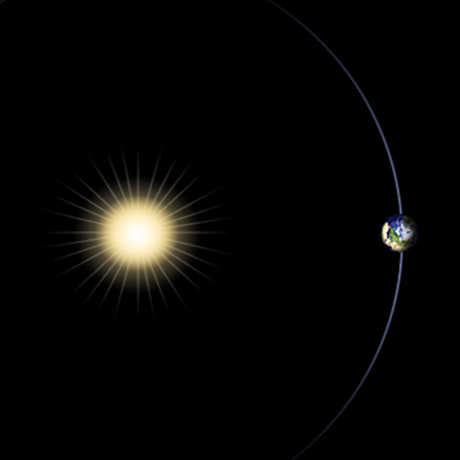
"The Plane of the Ecliptic" © 2017 NASA
Because of the different amounts of time it take for Mars and the Earth to each orbit the sun, it sometimes may look like Mars is traveling backwards. In this interactive lesson, students will learn what "retrograde" and "opposition" means in astronomy while modeling this phenomenon.
In this activity, students will:
- understand that planets take different amounts of time to move around the sun.
- be able to explain why people on earth cannot always see all of the planets.
- learn why planets were once called “wandering stars.”
- define the terms: opposition, conjunction and retrograde in regard to astronomy.
Follow the instructions in Kinesthetic Astronomy: Set Up to set up your kinesthetic circle. Mark an additional Mars orbit outside of your Earth orbit with 24 pieces of tape, aligning every other Mars marker with one of the Earth markers.
- conjunction: a position when two or more celestial bodies appear to meet or pass in the same degree of the zodiac
- opposition: a position when two celestial bodies are opposite in the sky from a certain viewpoint (usually on Earth).
- orbit: the path described by one celestial body in its revolution about another
- orbital period: the time taken for a given object to make one complete orbit about another object; the earth takes 365 days to orbit the sun.
- retrograde: when a planet appears to be moving backwards; caused by the length of different orbits.
- solar system: a sun with the celestial bodies that revolve around it in its gravitational field
- Have two students volunteer- one to play the role of the Earth and the other to play the role of Mars. Everyone else can gather around the kinesthetic circle to observe the activity.
- Have the students stand at Mars opposition (lined up with each other on the orbits).
- Show the students how each piece of tape on the floor represents an Earth month.
- Have the group clap out a slow beat. Each time there is a beat the planets step from one month to the next, pacing out their orbits. Once the planets have had the chance to make a few complete orbits, ask the students some questions.
- How often does Mars opposition happen? (once every 2 years)
- Can people on earth see Mars throughout the entire year?
- Perform the “dance” again, pausing at different places (6 earth months, one earth year, etc.) to see how aligned Mars and Earth are.
- Have students illustrate progressive drawings of what they would see on earth as time goes by in their science notebooks.
- Why was Mars called the wandering star? (because it looked bright and changed orientation with the zodiac)
For the inner planets, have students try to figure out when they might be able to see them in the night sky. (Since Venus orbits closer to the Sun than the Earth, it will always be relatively close to the Sun from our perspective. It will either appear in the sky in the West, after the Sun has gone down in the evening. Or rise before the Sun in the East in the morning. That's why they call Venus the morning star).
Opposition is a term used to indicate when one celestial body is on the opposite side of the sky when viewed from a particular place (usually the Earth).
An opposition occurs when the planet is opposite from the Sun, relative to the Earth. At opposition the planet will rise as the Sun sets and will set as the Sun rises providing an entire night of observation (just like with a full moon). Also at opposition the planet comes physically closest to the Earth in its orbit so it appears as large as possible. For planets outside the Earth's orbit (Mars, Jupiter, Saturn, Uranus, Neptune and Pluto), the months around oppositions are the best time to view these. Conversely, during a conjunction, a planet is in line with the sun and impossible to see at all.
A Mars year (orbital period) is equal to 2.135 Earth years. Therefore approximately every 2 earth years Mars is in opposition. When oppositions occur, it is ideal not only to observe the planets, but also to send spacecraft out to the planet. The first space craft that visited Mars was the Mariner in 1964. 2010 was the first year that NASA did not send a new spacecraft during its opposition since 1996.
Looking up in the sky each night at the same time, usually you would observe that Mars is a little further east each night compared to the constellations. However, about every two years there are a couple of months when Mars appears to move from east to west when observed at the same time (retrograde motion).
This backward or retrograde motion was mysterious to the early observers, and led to the use of the word "planet", from the Greek term which means "wanderer".
It is in a short period including the time of opposition when Mars exhibits its retrograde motion to an observer on the Earth. As the Earth moves forward in its orbit, Mars will appear to slip backward compared to its more common eastward march across the sky.
This lesson is adapted from the Kinesthetic Astronomy program developed by the Space Science Institute, 2004. Additional information on Mars’ apparent motion can be found at here.
Image: "The Plane of the Ecliptic" by NASA; originally sourced from https://www.nasa.gov/multimedia/imagegallery/image_feature_635.html
This lesson is adapted from the Kinesthetic Astronomy program developed by the Space Science Institute, 2004. Additional information on Mars’ apparent motion can be found at here.
Middle School
MS-ESS1-3: Analyze and interpret data to determine scale properties of objects in the solar system.
MS-ESS1-2: Develop and use a model to describe the role of gravity in the motions within galaxies and the solar system.


